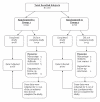Effect of iron content on the tolerability of prenatal multivitamins in pregnancy
- PMID: 18482454
- PMCID: PMC2405769
- DOI: 10.1186/1471-2393-8-17
Effect of iron content on the tolerability of prenatal multivitamins in pregnancy
Abstract
Background: Gastrointestinal irritability can deter pregnant women from starting or continuing prenatal multivitamin supplementation. In a previous study, suboptimal tolerability was observed among pregnant women taking a large tablet (18 mm x 8 mm x 8 mm) multivitamin with high elemental iron content (60 mg as ferrous fumarate). The objective of the present study was to compare rates of adherence and reported adverse events among pregnant women who were randomized to commence supplementation with a small-tablet prenatal multivitamin, containing either low or high iron content.
Methods: Pregnant women who called the Motherisk Program (Hospital for Sick Children, Toronto) and had not started taking or had discontinued any multivitamin due to adverse events were included in this prospective, randomized, open-label, 2-arm study. Women were randomized to take a small-size (16 mm x 9 mm x 4 mm), low elemental iron content (35 mg as ferrous fumarate) multivitamin ('35 mg' group); or a small-size (5 mm radius, 5 mm thickness), high elemental iron content (60 mg as ferrous sulphate) multivitamin ('60 mg' group). Follow-up interviews documented pill intake and adverse events. Rates of adherence and adverse events were compared between groups using chi-squared tests and Kaplan-Meier survival curves.
Results: Of 167 randomized women, 92 in the '35 mg' group and 75 in the '60 mg' group were included in the analysis. Despite ideal conditions and regular follow-ups, mean adherence based on pill intake recall, in both groups was approximately 50%. No statistically significant difference was detected in proportions of women who actually started taking either multivitamin. Among those who started, no difference was detected in rates of adherence or reported adverse events.
Conclusion: The present results suggest that iron content is not a major determinant of adherence to prenatal multivitamins. Combined with our previous study, tablet size may be the more definitive factor affecting adherence.
Figures



References
-
- Food and Nutrition Board . Dietary reference intakes for thiamin, riboflavin, niacin, vitamin B6, folate, vitamin B12, pantothenic acid, biotin and choline. Washington, DC: National Academy Press; 1998. - PubMed
-
- Institute of Medicine. Food and Nutrition Board . Dietary Reference Intakes for Vitamin A, Vitamin K, Arsenic, Boron, Chromium, Copper, Iodine, Iron, Manganese, Molybdenum, Nickel, Silicon, Vanadium and Zinc. Washington, DC: National Academy Press; 2001. - PubMed
-
- CDC Recommendations to prevent and control iron deficiency in the United States. Centers for Disease Control and Prevention. MMWR Recomm Rep. 1998;47:1–29. - PubMed
-
- Health Canada Eating Well with Canada's Food Guide: A Resource for Educators and Communicators. 2007. http://www.healthcanada.gc.ca/foodguide
-
- Health Canada Nutrition for a healthy pregnancy National guidelines for the childbearing years, Minister of Public Works and Government Services Canada, Ottawa. 1999.
Publication types
MeSH terms
Substances
LinkOut - more resources
Full Text Sources
Other Literature Sources
Medical

